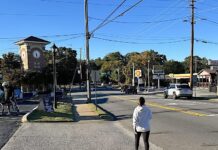
Hall County and the surrounding North Georgia region saw the positive rate of COVID tests nearly triple following the Fourth of July weekend. Now, with the long Labor Day weekend upon us, local healthcare providers are urging people to take steps to prevent similar community spread.


The state saw a record number of COVID cases and deaths in July and August. That trend has just recently begun to subside. But Delzell and others fear it could happen again. He urges people to “celebrate Labor Day safely” and help stop the spread by avoiding large parties and following the 3Ws – wearing masks around others, watching your distance, and washing your hands.
Serving more than 1 million people across the region through four hospitals and numerous outpatient locations, Northeast Georgia Health System (NGHS) is the largest healthcare system in Northeast Georgia. It began tracking COVID cases closely to help give area residents a better idea of the impact the virus is having locally.
The NGHS7-day average of positive COVID tests hovered between 5-10% in May and June. Those levels were in line with the state average and the World Health Organization’s (WHO) recommendation that the positive rate should remain at 5% or lower for 14 days before communities fully reopen all services. On July 4, though, the NGHS rate jumped to 11.5% – then leapt to a record 28% by July 16. Many of those infections occurred over the Memorial Day weekend, according to a report from Dr. Amber Schmidtke, who is a former Mercer University School of Medicine professor and a medical microbiology and immunology expert.

“It’s taken a lot of hard work by this community to steadily lower the positivity rate, which is now at 15%,” says Dr. Supriya Mannepalli, Northeast Georgia Medical Center’s medical director of Infectious Disease Medicine. “While that’s still higher than the state average of 10% and the 5% goal set by the WHO, it’s still great progress trending in the right direction.” She adds, “We need to continue to work together to keep that positive momentum – especially as we head into a holiday weekend.”
Now that schools are back in session, high school sports are in full swing, and the flu season is starting, Mannipelli says taking simple precautions can “help keep the people of this community, as well as local schools and businesses, healthy.”
The latest COVID data from NGHS is updated each day at nghs.com/latest-covid-19-data.






